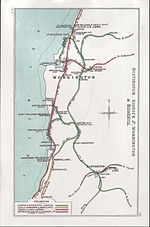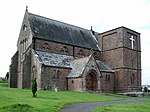Rose Hill Platform served workmen in the Rose Hill area of Harrington in the former county of Cumberland, England, which is now part of Cumbria.
The halt was on the Harrington and Lowca Light Railway where it connected with the Cleator & Workington Junction Railway (CWJR) a short distance north of Copperas Hill and south of Harrington Village. Workmen's services to and from Lowca variously ran from Moss Bay Cart Siding, Maryport (during the First World War), Workington Central and Seaton (Cumbria). Public passenger trains ran to these last two only.
There is no evidence that any advertised public service ever called at the halt. The public passenger service through its site, plying between Lowca and Workington Central called at Rosehill (Archer Street Halt) which was some 250 yards to the north.
A workmen's service ran north from Lowca from April 1912. It appears to have called at Rose Hill Platform, but there is considerable doubt if there was even a physical platform in place.
Details of the workmen's service are sketchy. A letter from Workington Iron and Steel Company's parliamentary agent to the Board of Trade on 2 December 1912 stated "..the line is being used [...] for the purpose of conveying workmen between Harrington and the works of the Promoters..." A photograph taken of the first public train on 2 June 1913 shows it at the workmen's platform at Lowca, the public platform yet not being ready. Standard works, notably Quick and Butt, make no mention of services at Lowca before 2 June 1913, nor at Micklam or Copperas Hill. They also give Rosehill (Archer Street Halt) as opening on 2 June 1913. This suggests that the workmen's service called at Moss Bay Cart Siding/Workington Central, Rose Hill Platform and Lowca Workmen's Platform. The mention of "...conveying workmen between Harrington and the works..." and entries in Croughton and Quick give tentative support to the Rose Hill Platform (a.k.a. Junction) call. Ex-employees writing later state "Miners' trains went up the private railway from Rosehill Box, where Pat McGuire, the "singing signalman" operated." Some later authors appear to conflate Rosehill Platform (a.k.a. Rose Hill Platform) and Archer St Halt.A public passenger service passed the halt between 2 June 1913 and May 1926. This was in essence an "upgraded" workmen's train, composed of the ancient workmen's coaches with a "public" coach tacked on. No source records this stopping between Archer Street and Copperas Hill. It is possible that when the public service ended in May 1926, the unadvertised workmen's trains which carried on until 1929 could have resorted to calling at Rose Hill Platform instead of or as well as Archer Street. Further research is needed.







